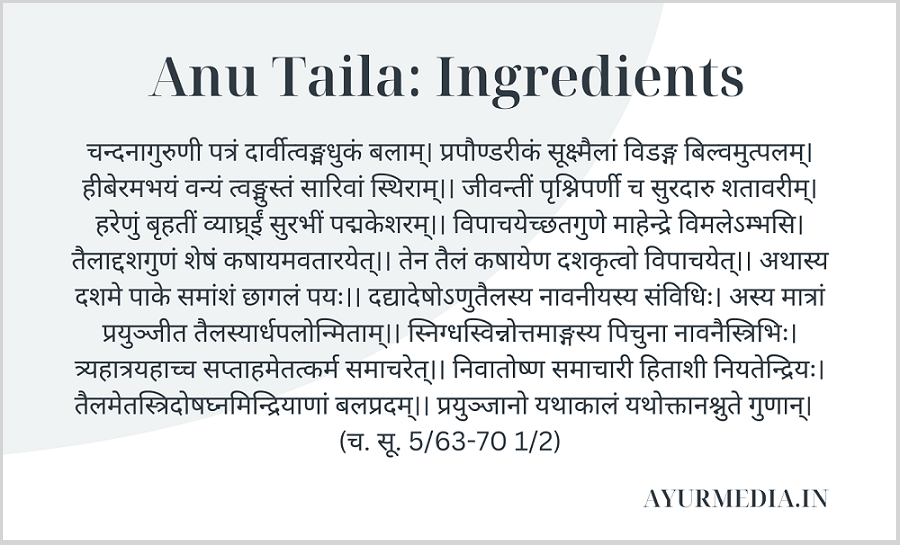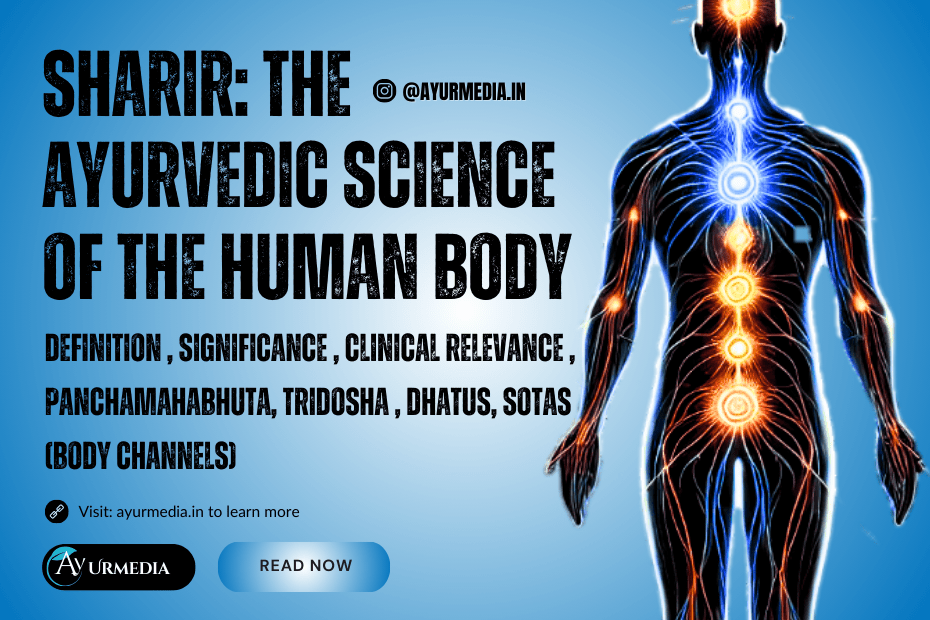Overview
Anu Thailam also called Anu Tailam or Anu Taila Nasya is an ancient Ayurvedic formulation described for Nasya Panchakarma treatment. Nasya means administering medication through the nasal passage.
Anu Thailam is an Ayurvedic medicated oil with a variety of indications in Ayurveda. It contains 27 herbal ingredients and Varsha Jala, sesame oil, and goat milk as liquid components.
Nasya is considered the most effective treatment for all diseases pertaining to the head region. A typical Nasya medication is Anu Thailam which treats all diseases related to the head.
Over the other oils, this is one of the most potent Nasya indicated for all types of Shiroroga (disease pertaining above clavicle).
How does Anu Thailam nasya karma work?
According to Ayurveda Nose is considered the entrance to Shira (Head), hence medication administered through the nasal root reaches the brain and calms the dosha.
Anu Thailam has the properties of Sookshmasrotogamiproperty, Mahagunam, and Sarvottam Gunam. It reaches the subtle sources in the head region and clears up obstructions, resulting in Samprapti Vighatana.
Its Vata-Pittahara properties help remove the aggravated doshas while its Brimhana (nourishing) property of Anu Tailam strengthens and improves the capacity of the Panchindriyas (five sense organs) including Nasa (Nose), Karna (Ear), and Netra (Eye).
Its most enormous effect prevents external infection from entering the body via the nasal passages.
Anu Thailam (Tailam) Indications
The conditions in which Anu Thailam Nasya is indicated are:
- Khalitya (hair fall), Palitya (premature greying of hair).
- Nasaroga (nose disorders) like Pinasa (catarrh), Sinusitis, and rhinitis.
- Pratishyaya (common cold).
- Gandhagyananasha (Loss of smell)
- Manya Stambha (torticolis).
- Shirahshula (headache).
- Ardita (facial paralysis).
- Hanu Sangraha (lock jaw).
- Ardhavabhedaka (Migraine).
- Peenasa (chronic coryza) and Shirakampa (head tremor).
Read Nasya Karma Contraindications.
Besides these, Anu Taila is indicated in all types of Shiroroga (disease of the ear, nose, and throat). It is pacifying for the Tridoshas and strengthens all the senses.
Anu Thailam Ingredients
Shloka, Sanskrit Verses—

Drava Dravya (Liquid contents) —
Til Taila (Sesam oil), Aja Dugdha (goat milk), Rain Water
| Drug Name | Botanical Name |
|---|---|
| Shweta Chandan | Santalum album |
| Agru | Aquilaria agallocha |
| Tejpatra | Cinnamomum tamala |
| Daruharidra Twak | Berberis aristata |
| Yashti Madhu (Mulaithi) | Glycyrrhiza Glabra |
| Bala | Sida cordifolia |
| Prapaundarika | Nymphaea lotus |
| Sukshma Ela (Cardamom) | (Elettaria cardamomum) |
| Vidanga | Embelia ribes |
| Bilwa | Aegle marmelos |
| Neelkamal | Nymphaea nouchali |
| Sugandhbala | Valeriana Officinalis |
| Khas | Chrysopogon zizanioides |
| Kevati motha | Cyperus tenuiflours |
| Dalchini | Cinnamomum zeylanicum |
| Nagarmotha | Cyperus rotundus |
| Sariva | Hemidesmus indicus |
| Shaliparni | Desmodium gangeticum |
| Jeevanti | Leptadenia reticulata |
| Prushniparni | Uraria picta |
| Devdaru | Cedrus deodara |
| Shatavari | Asparagus racemosus |
| Renuka | Vitex agnus-castus |
| Brihati | Solanum indicum |
| Kantakari | Solanum virginianum |
| Kundru | Coccinia grandis |
| Padmakeshar | Nelumbo nucifera Gaertn |
Anu Thailam Uses and Benefits
According to Ayurveda, the nose is considered to be the gateway to the brain. As a result, Anu Thailam Nasya has evident action in curing the disease of the Jatruurdhwa (body parts above the clavicle), such as Manya Stambha (torticollis), Shirahshula (headache), Ardita (facial paralysis), Hanugrah, Pinasa (catarrh), Ardhavabhedaka (migraine), and Shirakampa (head tremor).
A comparative clinical study shows significant results in the treatment of Ardhavabhedaka (migraine) by Anu Tailam and Shadbindu Taila1Akhilanath Parida*; Satyasmita Jena; Varun Sawant. CLINICAL STUDY TO COMPARE THE EFFICACY OF NASYA KARMA WITH SHADBINDU TAILA AND ANU TAILA IN MIGRAINE VIS-O-VIS ARDHAVABHEDAKA. ayush 2020, 6, 2415-2422..
Strengthen the sense organs
Anu Thailam is described as Sukshmasrtotogami due to which Oil reaches the subtle channels and clears up the obstruction and removes the doshas by mobilizing them.
Its Bruhana (nourishing) action takes place on the vital points (marmas) of the head, for example, Shringataka and strengthens the ear, nose, and throat thus helping in improved capacity and perception of the senses.
According to Charaka Samhita, regular use of Anu Tailam improves the efficiency of the Indriyas, the clarity of voice, and facial glow.
Moreover, regular use of Anu Taila does not cause recurrent ear, nose, and throat diseases.
Anu Thailam uses for nose
Anu Thailam is administered through the nasal passage so it lubricates the nose, clears up the obstruction, and prevents external infection from entering the body. Therefore, it is useful for Nasaroga (nose disorders), for example, Sinusitis and rhinitis, and Pratishyaya (common cold).
Moreover, it acts on all the vital areas of the head (Marmas) and cures the disease.
Anu Thailam uses for Sinusitis
According to Ayurveda, Anu Thailam consists of Shirovirechakdravya which pacifies Vata and relieves symptoms associated with frontal sinusitis. There is also evidence that it is effective against the frontal sinuses according to a case study.
In a clinical study, Patients with chronic sinusitis were given Tribhuvan Kirti rasa along with Dasamulakwath steam inhalation and Nasya (intranasal instillation) with Anu Tailam. Clinically, the medicine was well tolerated and its efficacy was 96.6%2Panigrahi H. K. (2006). Efficacy of ayurvedic medicine in the treatment of uncomplicated chronic sinusitis. Ancient science of life, 26(1-2), 6–11..
Anu Thailam benefits for hair
Its Sookshmasrotogamiproperty and Romakoopa Vishodhanaproperty remove obstructions in the hair roots, while Brinhana and Vata-pitta har properties prevent hair fall and premature graying and promote new hair growth.
It is described in the Charaka Samhita that for those who use Anu Thailam Nasya in due course, the power of their senses increases. Their hair does not turn white, or grey and falls quickly. Instead, grows excellently.
A single case study on the efficacy of Anu Tailam Nasya in Khalitya (hair loss) shows significant improvement and outcomes3Dr. Jyothi S.; Dr. Ashwini MJ. A Single Case Study on the Efficacy of Anu Taila Nasya Followed by Narasimha Rasayana in Khalithya Vis-à-Vis Androgenic Alopecia. J Ayurveda Integr Med Sci 2021, 6, 232-238..
Anu Thailum Method of preparation
All the herbs are taken in equal quantity and boiled in 100 times pure water till one-tenth remains. In this way, the decoction is obtained. Now the sesame oil and the decoction are taken in a separate vessel and boiled till only oil remains and this process is repeated 9 times.
Finally, the Goat Milk is added and boiled until only oil remains.
Anu Thailam dosage
- 1/2 Pala (24 ml) Thrice Weekly / 2 drops per nostril or as prescribed by the Ayurvedic physician.
How to use Anu Thailam
- Generally, Nasya is given to the patient in the morning after bowel movement, urination, and brushing of teeth. Then the patient is made to sit in a chair and a light massage is done on the face and neck.
- In the case of Nasya for hair loss, the same massage is also given on the scalp, for which Mahanarayan oil is used. This is followed by heat or sudation therapy.
- Finally, Lukewarm Nasya oil is instilled drop by drop into each nostril. If Nasya is given in the form of powder, the powdered medicine is blown in each nostril. The dosage of the Nasya medicine to be given depends on the type of Nasya or dosha imbalance.
- After Nasya karma, Dhumpana and Kawala-Gandusha are given and a light diet is recommended.
For individuals seeking self-administration, it is best to first consult an Ayurvedic practitioner.
One can follow all the basic steps mentioned above eg. After passing all the natural urges, a lighter massage on the face/neck/scalp followed by heat therapy (washing face with warm water), and then the Lukewarm Nasya oil should be instilled dropwise in each nostril.
Suitable time for Anu Thailam Nasya Karma
As per the Charaka Samhita, one should take the Anu Thailam nasal drop every year in the rainy, autumn, and spring seasons when the sky is free from clouds. Anu Tailam Pratimarsha Nasya can also be taken as a Dincharya (daily routine) procedure or at any time in any age group.
Read Nasya Administration Process.
Anu Thailum Precaution
- After Nasya karma, the patient should avoid curd, heavy meals, and cold air.
- It is best to take Nasya medicine at a lukewarm temperature; to do this, the oil should be heated on a hot waterbed.
- The patient should drink hot water.
- Should live in a warm environment.
- Polluted environments should be avoided.
Can we use Anu Taila at night?
Yes, 2 drops of Anu Taila can be taken in each nostril at night. It is advisable to take Nasya in the morning upon waking from sleep. This will help flush out the phlegm accumulation in the nasal passage.
Is Anu Taila helpful in Anxiety?
Anu Taila strengthens and soothes nerves thus it can be beneficial for nervous disorders. According to a comparative clinical study, Anu Taila Pratimarsha Nasya is highly effective as a Dinacharya procedure (Daily routine) for Generalized Anxiety Disorder4Hiremath N. & Kulkarni M. (2021). A comparative study of brahmi taila and anutaila pratimarsha nasya in management of Generalized Anxiety Disorder (GAD). International Journal of Indian Psychology, 9(1), 137-147. DIP:18.01.016/20210901, DOI:10.25215/0901.016.
Is Anu Oil Good for Allergies?
Anu oil mainly acts on the nasal passages and removes the blockage. It prevents external infections from entering the body and thus helps in relieving nasal disorders like allergic rhinitis, common cold, sinusitis, etc.
Anu Thailam side effects
- Anu Thailam Nasya does not induce any adverse reaction. It has been found to be well tolerated and no serious side effects have been reported from the use of the drug.
- Nasya is a non-invasive method and is considered suitable and safe, although slight burning sensation, congestion, and throat irritation may occur. These are temporary symptoms and are tolerable without any complications.
References
- 1Akhilanath Parida*; Satyasmita Jena; Varun Sawant. CLINICAL STUDY TO COMPARE THE EFFICACY OF NASYA KARMA WITH SHADBINDU TAILA AND ANU TAILA IN MIGRAINE VIS-O-VIS ARDHAVABHEDAKA. ayush 2020, 6, 2415-2422.
- 2Panigrahi H. K. (2006). Efficacy of ayurvedic medicine in the treatment of uncomplicated chronic sinusitis. Ancient science of life, 26(1-2), 6–11.
- 3Dr. Jyothi S.; Dr. Ashwini MJ. A Single Case Study on the Efficacy of Anu Taila Nasya Followed by Narasimha Rasayana in Khalithya Vis-à-Vis Androgenic Alopecia. J Ayurveda Integr Med Sci 2021, 6, 232-238.
- 4Hiremath N. & Kulkarni M. (2021). A comparative study of brahmi taila and anutaila pratimarsha nasya in management of Generalized Anxiety Disorder (GAD). International Journal of Indian Psychology, 9(1), 137-147. DIP:18.01.016/20210901, DOI:10.25215/0901.016



